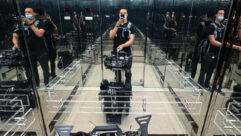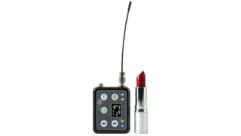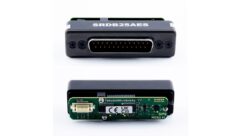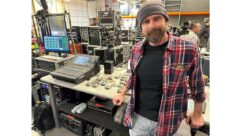Peer Review- Lectrosonics DM1624 Digital Matrix Mixer
Peer Review- Lectrosonics DM1624 Digital Matrix Mixer; Price: $4,550 MSRP
My Pick:
Lectrosonics DM1624 digital matrix mixer with DSP, $4,550 MSRP
What I Like About It:
The Lectrosonics DM1624 is a combination automatic microphone mixer, signal routing matrix, and digital signal processor that fits a wide range of applications. Two particularly neat features are the individual automatic feedback filters for each of the 16 input channels, and the ability to select whether an input is operated in auto-mix or direct mode for any of the 24 outputs.
The mixer can operate in a completely standalone manner, or be controlled via programmable input ports and/or serial interface. This provides the flexibility to give a client as much or as little user control as necessary for the application.
I Would Change:
The built-in macro programming commands are a powerful tool for carrying out complex sequences based on an external control input, but I think they’d be greatly enhanced with the addition of conditional statements that would allow the mixer to decide what to do based on present conditions.
It would also be nice if Lectrosonics included a pop-up window in the setup software that would warn you if you tried to exit without saving the setup to one of the presets.
Where I Used It:
I used the Lectrosonics DM1624 in the D.C. Bar Association conference center in Washington, D.C.
Peer Review- Lectrosonics DM1624 Digital Matrix Mixer
Peer Review- Lectrosonics DM1624 Digital Matrix Mixer; Price: $4,550 MSRP
SUBMIT A PEER REVIEWMANUFACTURER SPECIFICATIONS
My Results:
The conference center at the D.C. Bar Association consists of three meeting spaces that can be combined to form two rooms or a single, large room. The clients needed sound reinforcement and multi-track recording for each room, as well as the ability to send audio to two overflow rooms. They also wanted a simpler user interface that could be easily understood. Their existing system had a series of selector panels to route the room audio to a pair of recorders and set up the various room combining configurations.
A single Lectrosonics DM1624 was installed as the heart of the system. Inputs to the mixer consisted of three wireless headset systems (one per room) and 12 hardwired jacks (four per room). Eighteen outputs were used to feed each of the three meeting rooms, two overflow rooms, two stereo digital media recorders, a FireWire digital recording interface, and an operator’s headphone. The mixer’s built-in DSP was used to provide individual room equalization for each of the meeting and overflow rooms, as well as feedback protection for each input channel.
An LCD touchscreen control panel was installed at the registration desk to serve as the user interface to the DM1624. A second panel was located at the equipment rack. Using a series of simple menu screens, the operators can control how the rooms are combined, which rooms feed the overflow rooms, which rooms feed each recorder, start and stop of each recorder, and which room audio feeds the operator’s headphone. Macros were written to perform the necessary input and output routing assignments when executed via serial commands from the touchpanels, which made it much easier to ensure that all the inputs were routed to the proper rooms and recorders as the various combinations were recalled.
In addition to the LCD panels, momentary rocker switches in each room were wired into the mixer’s programmable control ports, and were configured to act as master volume controls. Momentary switches were selected over conventional potentiometers, as it ensured the volume levels would return to a predetermined setting upon power up.
At the conclusion of the project, the client was pleased with both the dramatic improvements in audio quality and the ease of control the Lectrosonics DM1624 provided.
In the end, the DM1624 replaced nine individual pieces of gear, cleaned up the audio, and simplified operation. Not a bad day’s work!
Always wanted to review a product? Contact the Pro AV staff at [email protected] to become one of our peer reviewers.
Gain: -10 dB to +60 dB, programmable in 1 dB steps
Input Impedance: 2.5 k ohm
Peer Review- Lectrosonics DM1624 Digital Matrix Mixer
Peer Review- Lectrosonics DM1624 Digital Matrix Mixer; Price: $4,550 MSRP
Phantom Voltage: 15 V, programmable
Nominal Level: 0 dBu all outputs, -40 dBu selectable on Outputs 9 through 12
Output Impedance: line only, 50 ohms differential line level only outputs; mic/line, 600 ohms differential programmable outputs at line level, 130 ohm differential programmable outputs at microphone level
Input Dynamic Range: 96 dB at -50 dBu input level, 102 dB at all other levels (unweighted 20 to 20 kHz)
Output Dynamic Range: 105 dB (unweighted 20 – 20 kHz)
IMD + Noise: 0.1% max., 0.02% nominal input level
THD + Noise: 0.1% (worst case), 0.02% nominal input level
EIN: -126 dBu
Connectors: Audio I/O, 5-pin Phoenix; expansion, RJ45; logic I/O, DB25; serial, standard USB and mini TRS
Transmission Speed: 50 Mb/s
Peer Review- Lectrosonics DM1624 Digital Matrix Mixer
Peer Review- Lectrosonics DM1624 Digital Matrix Mixer; Price: $4,550 MSRP
Power Requirements: 100-240 VAC, 47-63 Hz
Power Consumption: 30 watts
Peer Reviewer: Scott Reidinger, president, Cardinal Sound & Communications, Silver Spring, MD. Cardinal Sound & Communications is a design-build professional audio contracting firm that has been serving the Washington, D.C., area since 1970.










